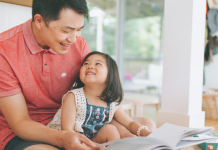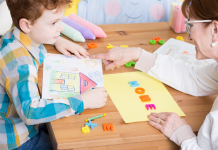It can be challenging to find engaging and stimulating ways to fill the hours of our days with our tiny humans (especially now, during this time of social distancing.) You can only play with the same stacking toy or block set for so long before you (both) start to fade. In my two-going-on-three (short) years of being a stay-at-home mama, and with my years of teaching early childhood, I have found that the best way to make it to dinner time with our sanity still intact is by making sure to have simple variety throughout the day and by having intentionally planned activities ready to go. Learning through play is crucial for healthy child development and learning.
A Quick Sensory Bin Guide for Littles
The secret weapon in my back pocket is the sensory bin. One of the things I love most about sensory bin play is you can make it as fancy or as minimalist as you want.
 The basics of a sensory bin are:
The basics of a sensory bin are:
- A tub, bin, or container of some kind
- A filler/medium
- Some tools or items to explore the medium with
Medium Ideas
When you make a sensory bin, you can basically take anything you have on hand already and turn it in to an exploratory activity. Flour, dried rice, dried beans, water, or craft materials (such as fabric scraps or tissue paper, ribbon swatches, gift wrap, pom poms, etc.) make for some engaging exploratory play with minimal mess. Be sure to think outside the box; it’s likely that you have some kind of material on hand in the pantry or a craft drawer that can be used for sensory bin play. If you’re stumped for medium ideas, you can always just use water!
Don’t be afraid to switch it up from time to time and experiment with different textures. Get creative, and go off of your child’s current interests if possible. For example, my daughter has recently been very interested in dinosaurs. We have a bag of play sand in our garage, so I scooped a couple cups of sand into a small plastic container and added a couple dino toys we had in the play room. She was engaged for much longer than I anticipated she would be, since she was very excited to explore the dinosaurs in the bin. I put an old towel under the bin to help consolidate any spilled sand and expedite clean up. If I didn’t have the play sand, I could have just thrown together a couple cups of flour, salt, or coffee grounds with the dino toys and she would’ve had just as much fun!

Boundaries
I am often asked how I keep my daughter from putting the bin materials in her mouth. In short? I don’t. She’s going to explore the materials however she sees fit, and sometimes that involves putting them in her mouth. Do I like that? No, but it does happen. Throughout our sensory play time, I’m constantly saying, “Out of your mouth!” over and over as a frequent reminder. She knows that’s the expectation, but sometimes, she gets carried away exploring and forgets. If she continually does it on purpose, I caution her that we will have to be all done if she continues to do so. This guideline applies to throwing the materials out of the bin as well.
In addition to, “Out of your mouth,” I’m also frequently saying, “Everything stays in the bin!” She will repeat these phrases because, by now, she’s very aware of the boundaries. I don’t make it a huge dramatic situation; she just knows if she continually and purposely crosses the line in regards to making a mess or putting materials in her mouth, then we clean it up and put it away. It took a few times until she fully grasped this concept, but now she knows, and it makes for a much more enjoyable experience for us both. She’s able to understand problem solving and cause & effect more clearly as a result.
Clean Up
I tend to put a towel or tarp of some kind under our sensory table or underneath a sensory bin. This helps to consolidate the inevitable mess and make for a quicker clean up. Now that my daughter is two, I involve her in the clean-up process, which she really enjoys because it helps establish her independence and responsibility. Don’t be afraid to involve your kiddos in mess clean up, even if it seems like a huge, daunting task! They may surprise you with what they can actually do. Even if they can’t effectively clean very well, they will at least be learning the importance of finishing what they start and taking responsibility for their mess and decisions.
Developmental Areas
Another aspect I love most about sensory bin play is how all-encompassing it is. Sensory activities cover many areas of development all at once. Fine motor development is worked on through the scooping, pouring, and physical manipulation of the materials. Cognitive development is stimulated in many ways including, but not at all limited to, attending to and engaging with the activity, persistence, problem solving, cause and effect, etc. Science concepts (making a hypothesis, experimenting), literacy concepts as they have discussions with you (or listen to your cognitive dialogue that you talk through aloud to them, if they’re nonverbal), mathematics (measuring, sink/float), and depending on what specific materials are involved, creative concepts such as art and music could be involved.
Almost every area of development is touched upon in some way with a sensory activity, and that is pretty incredible! It looks like such a simple, play-based experience, but it actually is helping your child develop many different skills that will enhance their development through play.

Don’t be afraid to utilize the sensory bin, mama! I know it can seem intimidating, but I promise you will get the hang of it and find the perfect combos and rhythm that work for you.
I love setting my daughter up with a sensory bin in the kitchen near me as I prep and cook dinner. It gives her something stimulating and engaging to do, and I’m able to supervise without it consuming me or fully taking me away from my task at hand.
If I’m using a themed sensory bin pertaining to whatever we’re focusing on in our learning, I tend to let that bin last a week and be reused each day. Otherwise, I just make random bins based on whatever we feel like doing. It can be as structured or as fluid as you desire. Some days, our sensory bins are super elaborate and carefully selected, and other days, I’m last-minute pouring flour into a bin and throwing in the first couple kitchen utensils I see. Your child will have a blast either way!
Happy exploring!












